Monaco's new €2bn neighbourhood rising out of the sea
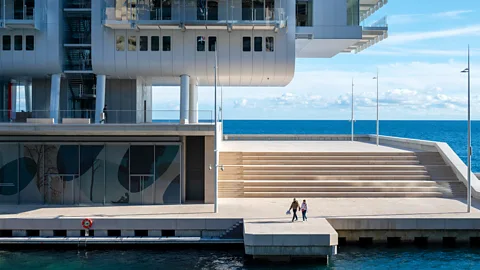 Getty Images
Getty ImagesBuilt on reclaimed land, Monaco's new Mareterra district blends cutting-edge sustainability with scenic sea views, offering a fresh way to explore the principality.
It was just past noon in Mareterra, Monaco's newest neighbourhood, and a crowd swelled on the terrace outside Marlow, the principality's first British fine-dining restaurant. Nearby, office workers stretched out on wide steps by the water for their lunch break. Promenade Prince Jacques, the 800m pedestrian walkway that sweeps around the sea-facing perimeter of Mareterra, was busy with parents pushing strollers and joggers pounding the concrete pavement. I paused to soak up the view across the expanse of blue sea towards the leafy Roquebrune-Cap-Martin headland and Italy beyond. The area blended so seamlessly with the surrounding landscape that I struggled to remember how, six months ago, this was still an unfinished construction site – and that eight years ago, where I stood was the Mediterranean Sea.
This reclaimed district, a €2bn project unveiled in December 2024, is Monaco's latest answer to a question it has faced for more than 150 years: how do you expand when you've already run out of land?
I walked along the promenade and ducked through a door along the path, entering a dark, concrete antechamber. Another door led through to the hollowed interior of one of 18 caissons, the 10,000 ton, 26m-high chambers that sit side by side like giant Lego bricks on the seafloor to create the maritime infrastructure of the new neighbourhood.
In the dark, unlit space, it took a while for my eyes to catch up to what my ears immediately recognised: waves, crashing against a wall then flopping back onto the water's surface. I peered over a thick railing separating me from the drop into the sea below. The Mediterranean surged up as if reaching for my attention, while the reinforced concrete chamber remained silent and immobile as it soaked up the impact of the swell.
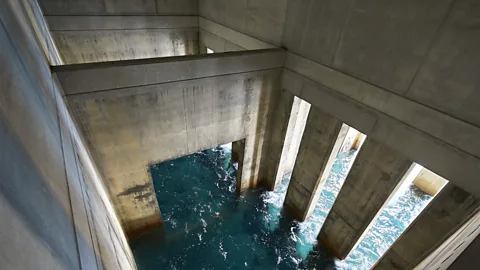 Hufton+Crow
Hufton+CrowThe top of the upper section of each caisson, which is known as the Jarlan chamber, is above the waterline to allow water to flow in and out through thin, vertical openings on the outward-facing side. The design has been engineered to act as a breakwater to absorb and disperse the energy of the waves.
"That means, even during 100-year storms, they won't rise too high nor submerge [Mareterra]," said Guy Thomas Levy-Soussan, the managing director of SAM L'Anse du Portier, the developers of Mareterra, as we stood in La Grotte Bleue, as this space is called, named after the Blue Grotto of Capri. "When the Sun shines through the openings in the Jarlan chamber in the morning, there's a slightly blue hue to the space," he said, explaining the choice of name.
Green Getaways
Green Getaways is a BBC Travel series that helps travellers experience a greener, cleaner approach to getting out and seeing the world.
La Grotte Bleue doesn't sparkle under the weight of four walls adorned in pastel pink and lavender purple quartz like its Instagram-pretty neighbour a couple of doors down, a meditation room for quiet contemplationdesigned by Vietnamese artist Tia-Thủy Nguyễn. And I probably would feel a little uneasy being in the dark space alone. Yet it has quickly become one of the Mediterranean principality's most unusual, and least glossy, landmarks, attracting a steady flow of people like me, curious for a behind-the-scenes glimpse of the technical ingenuity involved in reclaiming land from the sea.
Land reclamation is nothing new in Monaco, the world's second-smallest country after the Vatican City, where 38,000 residents cram into a territory just more than 22sq km in size. While a high proportion of that figure are millionaires, they're still living in the most densely populated country in the world.
Hemmed in by France, Monaco's default solution to its space issue is to extend out into the water. Since 1907, 25% of Monaco's territory has been reclaimed, including the principality's beachfront, Larvotto, the superyacht-lined Port Hercules and the Fontvieille district to the west of the Prince's Palace of Monaco.
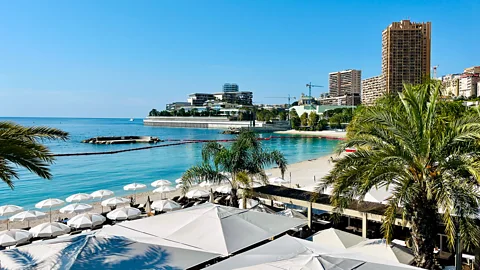 Chrissie McClatchie
Chrissie McClatchieIf Prince Rainier III, who came to power in 1949, carved out a reputation as "the builder prince", his son and current sovereign, Prince Albert II, is continuing the tradition. It was in 2013 when he announced plans to reclaim these six hectares just off the coast near Larvotto at Monaco's eastern extent, later naming it Mareterra to reflect its connection to the sea and the land. The neighbourhood has increased the principality's territory by 3% and comprises two residential apartment blocks (including one designed by celebrated Italian architect Renzo Piano), 10 villas and four townhouses, a small marina, 14 commercial spaces and three hectares of public space.
Plan your trip:
When to go: May (and, as of 2026, early June) if you're motorsport mad, otherwise anytime but then. Visit in late June and early September, before the Monaco Yacht Show, for hot days without the crowds.
Where to stay: Opening just in time for the 2025 Monaco Grand Prix after a major renovation, Hotel Metropole has a prime position across from the Casino de Monte-Carlo. Upgrades will include a new spa by Guerlain and newly redesigned rooms, the first major facelift to the accommodation since the property opened in 2004.
Where to eat: Marlow on Place Princesse Gabriella for British fine dining; Sexy Tacos on Plage Larvotto for fiery Mexican cuisine. Across the road from the Grimaldi Forum, Sass Café is the principality's classic late-night address.
Mareterra fits like the missing piece of a puzzle into this stretch of Monaco's coastline. It is latched alongside the Grimaldi Forum, an event space that often hosts travelling art exhibitions and stage shows, and the Japanese Garden, planted in 1994 with Mediterranean pines, pomegranate and olive trees in accordance with Zen design principles. Both sites have been able to grow in size thanks to the extension.
In line with the Prince's commitment to make the principality carbon neutral by 2050, Mareterra has also been imagined as Monaco's greenest corner. Nine thousand square metres of solar panels, 200 EV charging stations and 800 trees are among the eco-friendly initiatives in the district.
Just inside the entrance to La Grotte Bleue, a five-minute long video plays on a loop, an introduction to how the project addressed the inevitable marine disruption that comes with such construction. The caissons hold a key role here, as well; reliefs and grooves were moulded into their construction to encourage marine flora and fauna colonisation. Segments were even sanded by hand to add texture. The Jarlan chambers have an additional bonus, recreating shallow areas where fish can dart in and out.
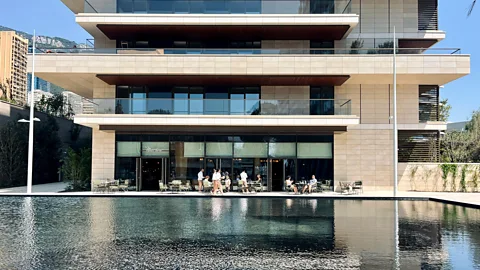 Chrissie McClatchie
Chrissie McClatchieThe most delicate of challenges, however, involved transplanting 384sq m of Posidonia oceanica, an endemic seagrass that plays a critical role in the Mediterranean ecosystem and is protected by EU legislation. A pioneering technique used a modified tree spade to scoop Posidonia sods into baskets which could then be replanted 200m away in the Larvotto Marine Protected Area. "Usually we transport Posidonia plants one by one," explained Sylvie Gobert, an oceanologist at the University of Liège in Belgium who worked on the project. "What is ultimately innovative is that we took the Posidonia, along with its entire root ecosystem and about a cubic metre of sediment."
More like this:
• Nordhavn: The Danish 'city' that's been designed for an easy life
If the Posidonia has ultimately settled into its new home, so has Monaco into Mareterra. As I surveyed the area, I realised how quickly the soft blues and greys of Le Renzo, Piano's striking residential block that stands sentinel over the neighbourhood, has become a familiar part of the local landscape. Nearby, Quatre Lances, a sculpture by American artist Alexander Calder that was purchased by Prince Albert's mother, Grace Kelly, in the 1960s and had been languishing in storage, has become a meeting point where people gravitate. A small nature walk, La Pinède, winds through a rocky garden planted with Aleppo and umbrella pines, the same species you would find if you were hiking through the Provence countryside. A water source gently trickled past birds' nests and insect hotels installed amid the Mediterranean shrub. These aren't the glossy attractions that Monaco is renowned for, like the gilded Casino de Monte-Carlo. It's an area that has been designed for locals, with only a handful of shops and restaurants, although visitors come to enjoy the peaceful gardens, sea views and the ingenuity of how Mareterra came to be.
Despite its ecological ambitions, Mareterra raises questions about necessity. Though billed as Monaco's answer to its housing challenges, property prices are speculated to start from €100,000 per square metre, making it some of the most expensive real estate in the world. Plus, none of the new residences have been reserved for Monegasques, who number nearly 10,000 and have a right to subsidised housing.
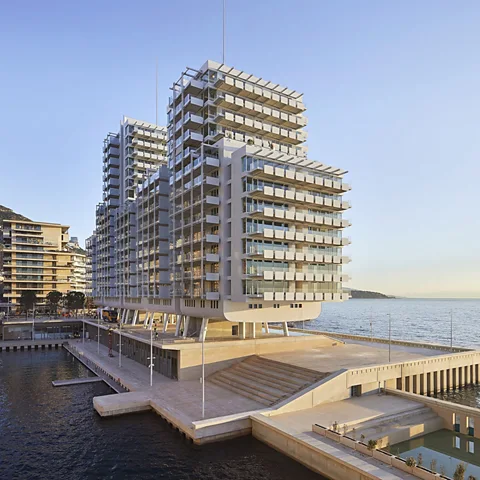 Hufton+Crow
Hufton+CrowHowever, those in Monaco are sure that Mareterra isn't the end of its growth story. "For Prince Albert, if there isn't construction, the country is at a standstill," said Nancy Heslin, co-founder of Carob Tree Publishing, Monaco's first all-female publishing house, who has interviewed the Prince on various occasions. "The country will always seek to continue to expand its territory."
"As long as it [has] the desire – and budget – to push the boundaries of what is possible on both a technological and ecological scale, the principality will be an example for other coastal cities to follow. As a laboratory for this kind of innovation," said Levy-Soussan, "Monaco is a small country that has done extraordinary things."
--
If you liked this story, sign up for The Essential List newsletter – a handpicked selection of features, videos and can't-miss news, delivered to your inbox twice a week.
